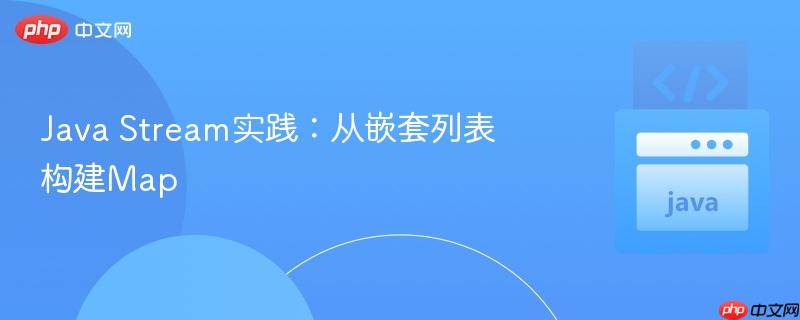
本文深入探讨如何利用java 8及更高版本的stream api和lambda表达式,将包含嵌套列表(例如,group对象中的list
在日常的Java开发中,我们经常会遇到需要将复杂的数据结构转换成更扁平、易于访问的Map形式。一个常见场景是,当一个主对象(例如Group)包含一个子对象列表(例如List
假设我们有一个Group模型,其中包含一个List
import java.util.HashMap;
import java.util.List;
import java.util.Map;
// 假设 Group 和 Entity 类已定义,并有 getKey() 方法
// class Group { String key; List<Entity> entities; /* getters */ }
// class Entity { String key; /* getters */ }
public class MapFromNestedListTraditional {
public static void main(String[] args) {
// 示例数据构建 (此处省略具体实现,假设 groups 已初始化)
List<Group> groups = createSampleGroups(); // 假设此方法返回示例数据
Map<String, String> entityGroupMap = new HashMap<>();
groups.forEach(group -> group.getEntities()
.forEach(entity -> entityGroupMap.put(entity.getKey(), group.getKey()))
);
System.out.println("传统方式生成的Map: " + entityGroupMap);
}
// 辅助方法:创建示例数据
private static List<Group> createSampleGroups() {
// ... 具体实现,例如:
// Entity e1 = new Entity("e1"); Entity e2 = new Entity("e2");
// Entity e3 = new Entity("e3"); Entity e4 = new Entity("e4");
// Group g1 = new Group("gA", Arrays.asList(e1, e2));
// Group g2 = new Group("gB", Arrays.asList(e3, e4));
// return Arrays.asList(g1, g2);
return List.of(
new Group("GroupA", List.of(new Entity("Entity1"), new Entity("Entity2"))),
new Group("GroupB", List.of(new Entity("Entity3"), new Entity("Entity4")))
);
}
// 模拟 Group 类
static class Group {
String key;
List<Entity> entities;
public Group(String key, List<Entity> entities) {
this.key = key;
this.entities = entities;
}
public String getKey() { return key; }
public List<Entity> getEntities() { return entities; }
@Override public String toString() { return "Group{" + "key='" + key + '\'' + ", entities=" + entities + '}'; }
}
// 模拟 Entity 类
static class Entity {
String key;
public Entity(String key) { this.key = key; }
public String getKey() { return key; }
@Override public String toString() { return "Entity{" + "key='" + key + '\'' + '}'; }
}
}这种方法虽然直观,但当数据结构更复杂或需要进行更多中间操作时,代码可能会变得冗长且不易维护。
Java Stream API提供了一种更函数式和声明式的方法来处理集合数据。对于上述需求,我们可以利用flatMap操作来扁平化嵌套结构,然后使用collect(Collectors.toMap(...))将结果收集到Map中。
立即学习“Java免费学习笔记(深入)”;
import java.util.AbstractMap;
import java.util.List;
import java.util.Map;
import java.util.stream.Collectors;
public class MapFromNestedListStream {
public static void main(String[] args) {
List<Group> groups = createSampleGroups(); // 使用与传统方式相同的辅助方法
Map<String, String> entityGroupMap = groups.stream()
.flatMap(group -> group.getEntities().stream() // 将每个Group的List<Entity>转换为Stream<Entity>
.map(entity -> Map.entry(entity.getKey(), group.getKey())) // 为每个Entity创建Map.Entry
)
.collect(Collectors.toMap(Map.Entry::getKey, Map.Entry::getValue)); // 收集到Map中
System.out.println("Stream方式生成的Map: " + entityGroupMap);
}
// 辅助方法:创建示例数据 (与上面相同)
private static List<Group> createSampleGroups() {
return List.of(
new Group("GroupA", List.of(new Entity("Entity1"), new Entity("Entity2"))),
new Group("GroupB", List.of(new Entity("Entity3"), new Entity("Entity4")))
);
}
// 模拟 Group 类 (与上面相同)
static class Group {
String key;
List<Entity> entities;
public Group(String key, List<Entity> entities) {
this.key = key;
this.entities = entities;
}
public String getKey() { return key; }
public List<Entity> getEntities() { return entities; }
@Override public String toString() { return "Group{" + "key='" + key + '\'' + ", entities=" + entities + '}'; }
}
// 模拟 Entity 类 (与上面相同)
static class Entity {
String key;
public Entity(String key) { this.key = key; }
public String getKey() { return key; }
@Override public String toString() { return "Entity{" + "key='" + key + '\'' + '}'; }
}
}Java版本兼容性: 示例中使用了Map.entry(key, value)方法,该方法在Java 9及更高版本中可用。如果您的项目使用的是Java 8,您可以使用AbstractMap.SimpleEntry或自定义的Pair类来替代,例如:
// Java 8 兼容 .map(entity -> new AbstractMap.SimpleEntry<>(entity.getKey(), group.getKey())) // ... .collect(Collectors.toMap(AbstractMap.SimpleEntry::getKey, AbstractMap.SimpleEntry::getValue));
键冲突处理: Collectors.toMap在默认情况下,如果遇到重复的键,会抛出IllegalStateException。如果您的entity.getKey()可能存在重复,并且您希望自定义冲突解决策略,可以使用Collectors.toMap的第三个参数——合并函数:
// 当键冲突时,保留旧值 .collect(Collectors.toMap(Map.Entry::getKey, Map.Entry::getValue, (oldValue, newValue) -> oldValue)); // 当键冲突时,使用新值 // .collect(Collectors.toMap(Map.Entry::getKey, Map.Entry::getValue, (oldValue, newValue) -> newValue));
空值处理: 如果entity.getKey()或group.getKey()可能返回null,并且您不希望Map中包含null键或null值,您需要在map操作之前或之后进行过滤。Collectors.toMap默认不允许null键或null值。
通过使用Java Stream API,特别是flatMap和Collectors.toMap,我们可以以一种声明式、简洁且高效的方式,将复杂的嵌套列表结构转换为扁平化的Map。这种方法不仅提高了代码的可读性和维护性,也充分利用了Java 8+新特性带来的便利,是现代Java数据处理的推荐实践。理解并熟练运用这些Stream操作,将极大提升您的编程效率和代码质量。
以上就是Java Stream实践:从嵌套列表构建Map的详细内容,更多请关注php中文网其它相关文章!

每个人都需要一台速度更快、更稳定的 PC。随着时间的推移,垃圾文件、旧注册表数据和不必要的后台进程会占用资源并降低性能。幸运的是,许多工具可以让 Windows 保持平稳运行。

Copyright 2014-2025 https://www.php.cn/ All Rights Reserved | php.cn | 湘ICP备2023035733号